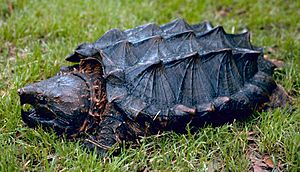Vulture turtle
| Vulture turtle | ||||||||||||
|---|---|---|---|---|---|---|---|---|---|---|---|---|

Vulture turtle ( Macrochelys temminckii ) |
||||||||||||
| Systematics | ||||||||||||
|
||||||||||||
| Scientific name | ||||||||||||
| Macrochelys temminckii | ||||||||||||
| ( Troost in Harlan , 1835) |
The vulture tortoise ( Macrochelys temminckii ) is a US native of the family of alligator tortoises (Chelydridae) and one of three species of the genus of vulture tortoises ( Macrochelys ). It is considered to be one of the largest freshwater turtles in the world.
Appearance
The carapace is brown, gray or black. On it, three strong keels are formed by the hump-like back shields . The rear edge of the carapace is roughly sawn. A special feature of the vulture turtle is a series of intermediate shields (supramarginals) between the rib and edge shields (costale and marginal). In young animals, this is a good distinguishing feature from the snapping turtle ( Chelydra serpentina ). The cross-shaped belly armor ( plastron ) is gray to yellowish-brown.
The head of the vulture turtle is massive and the strongly hooked upper jaw is elongated like a beak, which gave this turtle its German name. Your eyes are directed sideways, but can also be directed forward before snapping shut. The head and neck are covered with bumpy, spiky tubercles . The tail is very long in relation to the carapace and has a hump keel on its upper side. The soft tissues are gray to brownish and darker above than below. There are webbed feet between the toes, which are covered with strong claws. Another special feature is their tongue . A reddish appendix sits on it, which is used to hunt prey. The males are larger than the females, and the distance from the plastron edge to the cloacal opening is greater. They reach a size of 90 cm. Large specimens can weigh up to 80 kilograms.
habitat
The habitat of the vulture turtle are larger bodies of water, rivers and lakes with soft, muddy ground. She also feels comfortable in brackish water . The river systems in which the turtle is found flow into the Gulf of Mexico .
Way of life
The vulture turtle is strongly bound to the water and actually only leaves it to lay eggs. She lies with her mouth open, sunk in the mud and moves the reddish tongue process. This attracts fish that try to catch the supposed worm. The turtle, on the other hand, snaps at the fish as soon as it swims into its mouth. It also preyed on water birds , frogs , snakes , smaller turtles, snails , worms and insects . She is also fed corn in captivity.
The animals mate from February to April. The 10 to 50 eggs are then laid in April to June. They are approximately 35 to 45 mm tall and take 100 to 110 days to hatch.
Systematics
For a long time, the vulture turtle was regarded as the only recent representative of its genus. In research, it took around 50 years before three biogeographically delimited species could be identified using morphological and molecular genetic methods.
Danger
The vulture turtle is endangered. It used to be common in their habitat, but was caught in large quantities for making turtle soup in the United States until the 1970s and 80s.
According to § 3 of the Federal Species Protection Ordinance, it is forbidden in Germany to own vulture turtles, to offer them, to keep them in stock for sale, to sell them, to give them to others or to breed them. The only exceptions are animal keeping under zoological expert management, which wholly or predominantly belong to legal entities under public law.
attitude
Free-range husbandry is possible in zoological gardens, although the facilities should be well secured, because this turtle is very vicious and can therefore cause considerable injuries. Group housing is only possible in spacious facilities in zoological gardens.
The water temperature should be 22 to 26 ° C. The tank or the possible holding container must be very large according to the size of the turtle and should be structured according to its way of life.
The prerequisite for breeding is a winter rest period of two months at around 15 ° C.
Trivia
In the summer of 2002, an abandoned vulture turtle was caught, which worried bathers at the Dornacher Weiher near Aschheim (Munich region). Since then she has been housed in the Institute for Zoology in Munich.
supporting documents
literature
- Manfred Rogner: Tortoises - biology, keeping, reproduction , Eugen Ulmer KG, Stuttgart 2008, ISBN 978-3-8001-5440-1
Individual evidence
- ↑ a b Manfred Rogner: Tortoises - Biology, Keeping, Reproduction , Eugen Ulmer KG, Stuttgart 2008, p. 58.
- ↑ a b Travis M. Thomas, Michael C. Granatosky, Jason R. Bourque, Kenneth L. Krysko, Paul E. Moler, Tany Gamble, Eric Suarez, Erin Leone, Joe Roman: Taxonomic assessment of Alligator Snapping Turtles (Chelydridae: Macrochelys ), with the description of two new species from the southeastern United States. Zootaxa, 3786, 2, pp. 141-165, 2014.
- ↑ Article from Spiegel Online http://www.spiegel.de/panorama/jagd-auf-geierschildkroete-das-ungeheuer-von-dornach-in-der-falle-a-203439.html accessed on August 21, 2014.
Web links
- Macrochelys temminckii in The Reptile Database
- Macrochelys temminckii inthe IUCN Red List of Threatened Species 2013.2. Listed by: Tortoise & Freshwater Turtle Specialist Group, 1996. Retrieved December 14, 2013.


